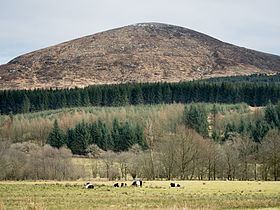OS grid NX501670 Elevation 711 m Mountain range Southern Uplands | Topo map OS Landranger 83 Prominence 522 m Parent range Southern Uplands | |
 | ||
Listing Marilyn, Donald, Graham Translation Great Cairn of Fleet (Scottish Gaelic + English) Location Dumfries and Galloway, Scotland Similar Craignaw, Cairns of Carsphairn, Merrick, Corserine, Kirriereoch Hill | ||
Cairnsmore of Fleet is a mountain in the Scottish Lowlands, on the edges of Galloway Forest Park. It is home to the most extensive area of open moorland in Galloway, and has been designated as a biosphere reserve.
Contents
- Map of Cairnsmore of Fleet Newton Stewart UK
- TopographyEdit
- WalkingEdit
- ClimbingEdit
- EcologyEdit
- References
Map of Cairnsmore of Fleet, Newton Stewart, UK
TopographyEdit
Cairnsmore of Fleet is an unafforested granite massif, whose highest point is about 10 km (6 mi) east of Newton Stewart in the south of Dumfries and Galloway (formerly Kirkcudbrightshire). It is the highest of the "Solway Hills", and overlooks the Cree Estuary and Wigtown Bay with views as far as the Lake District, Isle of Man and Snowdonia .
WalkingEdit
The usual route of ascent is the "Tourist Route", which is one of the most popular hikes in Galloway . It starts in the south-west, near Stronord, before climbing through the Bardrochwood Moor forest on to the summit. The Cairnsmore estate, near the start of this path, is the location mentioned in John Buchan's 1915 thriller The Thirty-nine Steps . Other routes reach the summit from the south, over the Knee of Cairnsmore, and from the north, over Meikle Mulltaggart .
ClimbingEdit
There are a number of good rock climbing areas on the subsidiary peaks around Cairnsmore of Fleet, but many of these have nesting birds on them so should be completely avoided in spring and early summer. The climbing is all on good quality granite. Areas that are described in the current guidebook include Craignelder, Loch Grannoch and the Clints of Dromore.
EcologyEdit
Cairnsmore of Fleet is home to many of the typical habitats of upland Britain, such as grasslands of purple moor grass (Molinia caerulea), Calluna vulgaris and Vaccinium myrtillus heaths and localised blanket mire with Trichophorum and cotton-grass (Eriophorum). The summit region is characterised by sheep's fescue (Festuca ovina), bilberry, Carex bigelowii and the moss Racomitrium lanuginosum . It one of the nine biosphere reserves in the United Kingdom , having been designated in 1976 . The original area of 1,922 ha was increased to 3,559 ha when the Cairnsmore of Fleet reserve was merged with the Merrick Kells and Silver Flowe nature reserve . The massif is also home to a variety of birds, mammals and invertebrates, including upland raptors such as the golden eagle, merlin, hen harrier and peregrine falcon, as well as a population of feral goats .
Red and black grouse are managed on the estates, and there is extensive grazing by domestic sheep (chiefly Scottish Blackface) and cattle, which helps maintain habitats for birds. This has been hampered by the decline in farming of traditional breeds, such as Belted Galloway cattle, with farmers keeping breeds more suited to lowland grazing .
Cairnsmore of Fleet is owned and managed by Scottish Natural Heritage .
